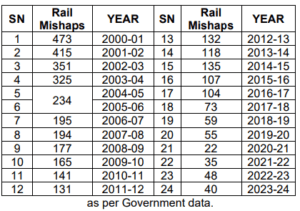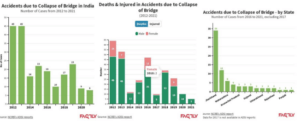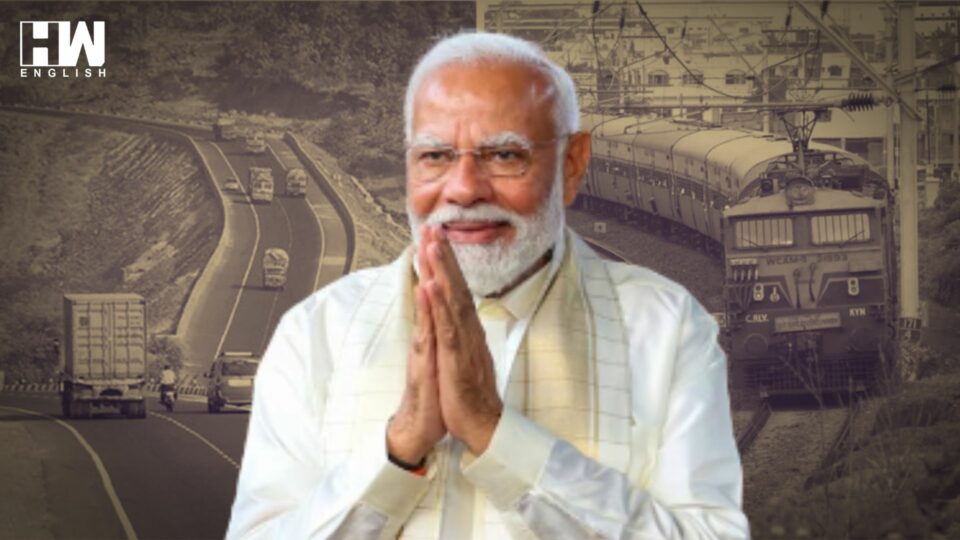Rakes like Vande Bharat Express and bullet trains add to the luxury, including state-of-the-art Railway stations. Still, they fall short of combining the reliability, security, and human safety offered
Supplementary infrastructural requirements hold the potential to significantly enhance the mobility of goods and people, thereby boosting productivity. However, to fully realise these benefits, the infrastructure must not just be built but built to adhere to better quality and safety standards.
Prioritising these standards can ensure the safety and well-being of the public and offer a promising future rather than focusing solely on political gains.
1. Our beloved PM carried out the prana prathista, which constituted the consecration of the Ram Mandir after a unique 11-day fast ritual. However, most of the Shankaracharyas opted out of the celebration. They disapproved of the haste in which the activity was carried out and declared the temple far from being complete. They felt it unholy to do the prana prathista prior to any incomplete temple work. A political motive, as per the religious men, is not sufficiently reasonable to hasten a holy process. However, the political options did not favour any further delay, with the elections weighing on the political conscience of the leaders. A heavy leakage was noticed at the temple top thereafter, close to the idol of Bhagwan Ram.
2. Despite the country-wide lockdown and the fear of COVID-19 infection, the Parliament House was hurriedly built to coincide with the general elections as part of the Central Vista project. This rush led to a significant rainwater leakage, which had to be collected in buckets to prevent overflow. Although the Prime Minister was victorious in the elections, the rushed infrastructure project resulted in a decrease in voter turnout and dented the seat count as well. The early-stage leaks in both cases, as soon as the buildings were functional, raised a crucial question: Was it a case of poor workmanship or the result of a top-down push for speedy completion? This question demands our collective attention and warrants a thorough debate, inviting all stakeholders to be part of the solution.
Whereas the above could be attributed to political events that were to follow, railway accidents that are consequential to human lives could be avoided. In almost a quarter of a century, we should have had a substantial reduction in the figures, converging to single digits, particularly when they pose a grave danger to human lives. Listed below are the calamitous train accidents since the year 2000.

Railways are a utility service and not a profit-making unit of the government. Rakes like Vande Bharat Express and bullet trains add to the luxury, including state-of-the-art Railway stations. Still, they fall short of combining the reliability, security, and human safety offered. More funds are required to boost such measures.
Adequate research was not carried out to reduce the frequency or intensity of the mishaps. Various measures were put on paper, including the installation of Kavach, an automated train protection system designed to prevent collisions on the same track. South East Central Railway (SECR) is currently implementing an automatic block signalling system through strategically placing signals by system integration, enhancing speed and capacity, and enabling multiple trains to operate in the same section.
A budgetary allocation of ₹2.52 lakh crore was made to the Railways, as against earnings of ₹2.56 lakh crore in 2023-24 from freight and passenger movement. Still, it is to be seen whether the allocations reflect on enabling the safety measures to gain precedence over the addition of rakes or the lavish railway stations. Despite his workload claims, PM Modi flagged off as many as ten additional rakes, carrying a truckload of photographers and a handful of mainstream media people with him!
The government wishes to introduce tangible objects like rakes and railway stations that are visible against intangible safety measures that get noticed only during accidents when a few hundred more lives would be lost!! Playing to the gallery for obvious reasons!
As per an NCRB report, the loss of human lives amounted to 285 in the last ten years (from 2012 to 2021) due to bridge collapse. The data in statistical form is as follows:

1. In the case of pedestrian bridges, it is essential not to permit excessive crowds to ferry past when only a fixed quota of people is allowed.
2. The trucks that transport goods should strictly carry the load designated by the manufacturer.
3. The bridge must be maintained periodically, and the following date of the inspection should be noted on the bridge’s notice board so that the concerned people know about it.
4. The investigation should commence from Jharkhand, which proved to be the centre of the collapse in terms of volumes. This could lead to several factors that served as deadly ingredients to the collapse.
5. Any corrupt practices following must be dealt with severely. In many of the recent cases, the collapse happened in tandem with the launch of the bridge, which led the commoner at large to doubt the genuineness of the materials used and the integrity of the contractor.
The focus above clearly indicates that the governments have little bearing on the quality of the work, but the onus is on the volumes that could turn on the electorate.
The roads that were made in quick succession and which catapulted our road-building standards to an optimum position worldwide cut a sorry figure after their completion. The multiple widened roadways boosted the infrastructure and were widely reported in many of the dailies, but the failed roads were featured only in a few columns and digital outfits as the din died down.
1. The Rapid Road Work technology applied to build a 375-meter stretch road by the Bengaluru Mahanagra Pallika (BBMP) and guaranteed to last for over 40 years developed cracks at the onset itself. The cost of the road-building exercise was ₹ ten crore/km, which was 30% more than regular roads.
2. Within six months of its opening, cracks were noticed on the road leading to India’s longest sea bridge, Atal Setu.
3. Within a few months of concretisation, the Wardha Road in Nagpur developed potholes, cracks, and peeling of the surface layer. The work, which included the construction of a footpath, cycling track, and stormwater drain along with concretisation, was valued at ₹114 crores.
4. The Badrinath National Highway has developed cracks, which are bound to deepen further and could compel the relocation of hundreds of families.
5. Mr. Nitin Gadkari is currently occupied with the road-building exercise and subsequently getting the same repaired for the cracks that it develops no sooner than when the PM inaugurates them.
The perpetual fact is that our beloved PM was consistently present to flag off the above events, although it might appear routine and insipid for his stature. However, it has never occurred to him that after doing the honours, the commoner expects the quality to be of a high degree and would be stunned to find the bridges crumbling and the roads developing cracks no sooner than the flagging off ceremony concludes. The PM’s availability is restricted only at the time of the preceding launch. The service to be provided and the additional costs that could be incurred are featured only in the secondary reports, which are primarily unread or unnoticed.
The leadership’s lack of enlightenment is evident from its short-term mindset, which focuses more on trying to preempt novel plans than on verifying the implementation and durability of the existing ones.
The onus is only on vote banks and the abundant reportage. The mainstream media is schooled to report the breakdown sparingly.
The views expressed by the author are strictly personal
As an independent media platform, we do not take advertisements from governments and corporate houses. It is you, our readers, who have supported us on our journey to do honest and unbiased journalism. Please contribute, so that we can continue to do the same in future.

